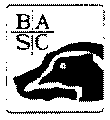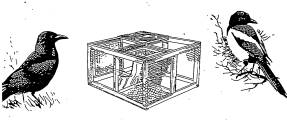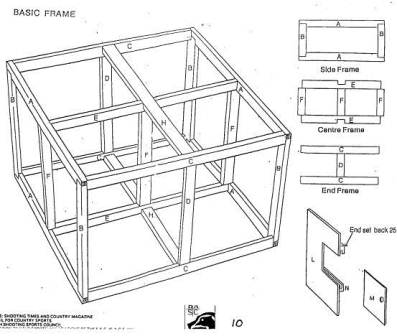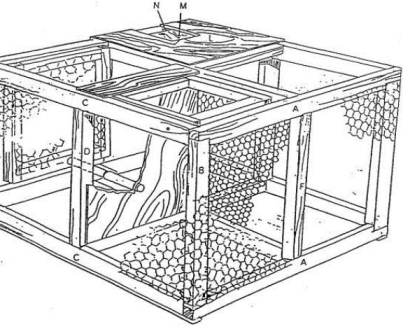ACKNOWLEDGEMENT
This
is a copy of an article that I have in my possession for years. It was a
photocopy and faded at the edges. I am not sure who produced it -
Shooting Times or B.A.S.C., or the date, as it states at the
bottom of each page:
OFFICIAL
WEEKLY MAGAZINE: SHOOTING TIMES AND COUNTRY MAGAZINE
FOUNDING
MEMBER: COUNCIL FOR COUNTRY SPORTS

BRITISH SHOOTING SPORTS COUNCIL
FEDERATION OF FIELD SPORTS ASSOCIATIONS OF THE E.E.C. (F.A.C.E. U.K.)
However, as both organisations are interested in furthering field
sports I'm sure they will not mind its reproduction here, in the
interest of controlling vermin.
_____________________________________________________________________________________________

HINTS
FOR USING LARSEN TRAPS
The
success of Larsen traps
Larsen
traps were designed by a Danish gamekeeper in the 1950ís. In Denmark,
it has been suggested that this trap alone was responsible for a
significant reduction in the national magpie population from 1965.
Larsen
traps will catch all corvid pest species (i.e. crows, magpies. jackdaws,
jays, rooks) at all times of year. but their particular value is
in catching crows and magpies when these birds set up their breeding
territories. The trap mechanism involves a spring door to each catching
compartment, which when set is held open by a split perch. In order to
enter the trap, birds the size of a magpie or crow inevitably drop onto
the perch. The perch gives way, and the birds momentum takes it past the
bottom of the door, which flips up - et voila! Because Larsen traps are
small, they can easily be moved around. Traps can be moved to deal with
specific pairs of crows or magpies, and a few traps can thus be made to
cover quite a large area.
Larsens
are live-catch traps. Why catch alive? Because of the risk of catching
birds other than corvids. Virtually all such non-target birds are
protected by law, and must be released alive and unharmed. In todayís
countryside, the future of shooting depends on gamekeeping having a
responsible image which treasures other aspects of the countryside, arid
is sensitive to the feelings of the wider public. Having said this, we
have experienced very few captures of non-target species in Larsen
traps, another point in their favour. In a survey of over 10,000 birds
captured only 1% were of non-target species. Finches and tits often
visit them, but are too small to trigger the mechanism, and can in any
case escape through the mesh sides. Of course, many legally protected
bird species, as well as gamebirds, suffer from corvid predation on
their eggs or young, and the Larsen trap is potentially an effective
tool in the conservation of these birds too. There is no Ďnatural
balanceí between corvids and the birds they prey on. because they also
feed to a great extent on other foods provided - directly or indirectly
- by man.
A
second reason to catch corvids alive is that each may in turn be used as
a call-bird to attract further captures. In this way, given that you
operate several traps, the whole effort quickly grows to an effective
scale within a single breeding season.
When to trap and why.
We
suggest that trapping effort is restricted to spring and early summer,
because It Is most efficient and most effective then. In most areas, the
overall population of crows and magpies is far greater than the number
of breeding pairs. This is apparently because only a limited number of
territories with a suitable nest tree at the centre can be fitted into a
given landscape. Non-breeding birds usually feed in flocks, roaming over
areas much larger than the usual territory. and using different foods
from those of territorial birds. Flock birds should be thought of as a
reservoir of frustrated would-be breeders. If a territory becomes vacant
it will rapidly be claimed by fresh birds from this reservoir. If you
trap outside the period March to July, you will have to diminish the
reservoir population over a very large area to cause any benefit to your
wild gamebird population.
Operating with call-birds
Why
call-birds work.
A call-bird is a previously-caught magpie or crow, which is kept
alive in the special compartment of the trap.
Uncaught territory holders think a single call-bird is an intruder, and
will try to drive it away. They
are very aggressive, and if the trap is left in peace, few are so
shy that they will not get caught. In a scientifically conducted
experiment by The Game Conservancy in 1989, traps with call-birds were fifteen
times more efficient at catching crows, ten times more efficient for
magpies.í
Taking
care of your call-birds.
Look
after your call-birds. They will work best for you when in good health,
because then they move about more in the trap and catch the attention of
territory holders. They also call vocally, but wonít do this if
miserable. Visit each call-bird at least once a day to renew food and
water. If they are seen by territory holders to be actively feeding,
they will arouse special jealousy. (Apart from this, you are bound by
animal welfare laws, and are furthermore responsible for the good image
of the shooting fraternity.) These birds drink a lot of water - earthenware
hamster bowls make very suitable non-tipping receptacles. Various kinds
of food are suitable, but we have found Ďsausagesí of brawn-type dog
food, fed with bread, to be very convenient. If carrion is fed, make
sure it is cut up or at least cut open as magpies can have great
difficulty in getting Into an intact carcass. Make sure the call-bird
has a proper perch - magpies and crows need them particularly for
roasting at night, arid there should be adequate shelter from hot sun,
rain or wind.
After
a while call-birds get quite tame and phlegmatic. Recently caught
territory-holders make the best call-birds. as they are more restless
and aggressive, so simply move new captures to act as call-bird In a
different territory, and keep a turn over of call-birds.
Which species to use as call-bird.
In
the wild, crows are dominant to magpies, and drive them from their
territories. For this reason, a crow will be attracted best to a
call-crow but also to a call-magpie; if you specifically want to catch
magpies, use only a call-magpie. On no account should species other than
corvids be used as decoys - In particular song-birds should never be
used.
Where
to put the trap.
If
you are familiar with your land, you will know the specific trees that
always seem to attract crow or magpie nests. If you are just getting to
know the area, look out for nest building activity from the beginning of
March. Before bud-burst, magpie nests are very obvious In the trees.
Crows, and to a lesser extent magpies, often sit high in the trees near
the centre of their territory, literally acting sentinel. You should aim
to place a trap in plain view of sentinels, and within 100 yards of the
nest site. If you havenít time to watch out for nests or sentinels,
concentrate on small copses and spinneys, thick hedges, and woodland
edge - but have you really got time to check the traps every day?
Avoid
placing traps too close to rookeries, unless you want a full-time job
dispatching or releasing rooks! We suggest that crows and magpies are
your main target to improve wild gamebird production.
Place
the trap on the ground, especially for crows, which like to approach on
the ground However, when trapping magpies amongst bushes, or in a dense
hedge, the use of four legs raises the trap above brambles and gives it
a better chance of being seen.
How
to catch both birds of a pair.
First
of all, it isnít strictly necessary to catch both birds of a pair.
They defend their territory together, and to remove one will often
prevent the remaining bird defending the area against a specuIating pair
of intruders: in this way its breeding effort is disrupted. Furthermore,
the male bird feeds the female while she is incubating the eggs - if he
doesnít turn up. the hen bird must leave the nest. If you keep up your
use of Larsen traps throughout spring and early summer, the
establishment of territories will be continually disrupted and while
present, fresh birds will be preoccupied with territorial defence and
nest building. Their demand for food is never swollen by the need to
feed young, and they have little time to watch the movements of
incubating gamebirds when the latter come off the nest to feed.
Crows
and magpies learn very quickly, and a bird that witnesses its partner
being removed from a trap by a human and killed will subsequently be
very shy of traps. If you catch a bird in one compartment of a Larsen
trap, leave it disputing its case through the wire with the call-bird.
Its partner, which may have been elsewhere up to now, will very often
join in and get caught in the other compartment. This is one of the
beauties of the three-compartment Larsen trap. However, if you have not
caught the other bird by nightfall, you probably never will: take out
the first capture. It is inhumane to leave one of these birds overnight
without a perch and without food and water for the next morning.
We
found no advantage in putting two, paired, magpies In the big
compartment as call-birds.
How
to handle call-birds.
Both
crows and magpies can give a fairly painful nip, but neither are really
capable of breaking the skin of an adult human. So donít worry about
getting hurt; concentrate rather on handling the bird securely but
gently. As you put your hand into the trap, a magpie will flutter round
the roof, while a crow will be trying to cram itself into a bottom
corner. In either case, trap the bird gently against the floor, roof or
side of the trap, sliding your first and second fingers round its neck
so that they meet at the fingertips. The bird canít bite you now, and
so long as you donít let it wriggle its head between these two
fingers, ft canít get away from you. Your palm will be over the birdís
back, and you can use your thumb and fourth and fifth fingers to pin the
wings against the body as you pick It up. Both species grip with their
feet: use your free hand to gently prise them open again. When taking
call-birds out of the big compartment of a Larsen trap, you will find
you have to bring them tail first through the access hole.
Birds
can be transported humanely to another trap In a dark box with
proper ventilation. Remember it is in your interests to look after the
bird.
How
to dispatch a captured corvid humanely.
If
you are right-handed, hold the bird as described above in your left
hand. With your right hand, grip the legs, tail, and wing tips together.
In one movement draw the bird out of your left hand, so that it doesnít
have time to bite you, and strike the back of Its head very hard against
the edge of the trap / Land Rover / etc. It takes a surprising force to
kill one of these birds. Do all you can to make death instantaneous.
Where to get your first call-bird.
Please
do not telephone us to ask where you can get a call-bird. Ask your
gamekeeper friends, or catch your own. Larsen traps work quite
effectively with bait alone - see next section. (You may even care to
keep a couple of tame birds from year to year to start you off each
spring.
They are really fascinating creatures, and if you take an
interest, you will learn a lot. We donít advise you to keep magpie and
crow in the same cage, or even adjacent cages.)
Operating with bait alone.
As
mentioned above, Larsen traps do catch crows, magpies, and other
corvids. when used with bait and no call-bird. You will need several to
be sure of success, and the strategy is rather different from that
described above.
Where
to put the trap.
Although
the trap should be obvious, birds will be more wary of it when
there is no call-bird. So It Is probably unwise to stand it out in the
open. Put it amongst bushes, or at the base of a hedge or tree.
In
contrast to using call-birds, it may take a while for your bait to be
spotted (because it doesnít move), or for birds to overcome their
natural fear of novel objects. So anticipate quite a long effort, but do
check your traps daily. Pre-baiting (with the trap unset) is
completely unnecessary - If a bird goes In, you might as well catch It.
If
your trap catches nothing at first, donít blame the trap. It is
probable that no corvids have found your bait. (After all many natural
bird nests escape predation.) Perhaps no corvid thought to look just
there. After 10-14 days. it rnay be best to move the trap to try another
site.
What bait?
The best bait by far is the egg. However, crows and
magpies seem to show a distinct seasonal response to eggs, and will only
show keen interest when eggs are naturally available. Outside late March
to late July, they are rather indifferent
When you use eggs, aim to make the offering look like a
depredated nest. Make a Ďnestí of dead grass in one (only one)
of the catching compartments, and arrange a clutch of five or six eggs
in it. Cracked or oversize gamebird eggs from the laying pen are
ideal, but hensí eggs (brown or white) seem just as attractive. Break
two or three eggs around the trap, and leave the eggshells lying about
Most important, on the flat board that shelters a call-bird when
present, or on the flat stop between the two catching compartments,
carefully break an egg so that the contents lie in a tempting puddle.
Renew this egg regularIy - it is the glistening fresh egg that
catches the corvid eye.
Of other baits, carrion is second best (open rabbits or
squirrels - again it is the freshly glistening viscera that attracts,
and both crows and magpies have limited powers of opening carcasses).
Even white sIiced bread may be used: it is eye-catching, fairly natural
in farmland (!), and they develop a taste for it. Again, a.
scatter of bait is more eye-catching, but donít overdo it, or the
birds will see no reason to enter the trap.
LARSEN TRAP CONSTRUCTION
The basic frame
1. Make
two side frames from parts A and B.
2. Make
carte frame with parts E and F. Note that the two outer struts (F)
overlap the ends of E by 25mm, and that the centre recesses in E are to
the outside of the frame. Cover with wire netting (V).
3. Make
two end frames with parts C and D.
4. Lay
one side frame on floor- Stand centre division in place and fix second
side frame to centre division.
5. Position
and fix end frames.
6. Invert
and fix other side frame to centre and end frames.
7. Fix 2
parts H into frame.
You now have the basic frame complete.
Completing the trap
1. Fit
ply division (Q) between end frame and centre division.
2. Construct
entrance to decoy compartment from parts L, M and
N. Ensure
rebated edges of parts N are flush with sides of cut-out
in part L.
3. Slide
door into position (part M).
4. Fix
completed entrance to basic frame, ensure
a.
that basic frame is square.
b.
that sliding door is captive on underside
c.
that wire netting on centre frame faces into decoy compartment
5.
Cover
decoy compartment top, trap ends, sides and bottom with wire netting
(Parts R, S & T).
6. Assemble
flap frames from parts J and K (refer to diagram to ensure correct
assembly) and cover with wire netting (part U).
7. Mark and
drill 6mm holes and centre top rails of basic frame (see diagram for
position).
8. Mark and
drill 5mm holes in flap frames (see diagram for position).
9. Insert rod through 6mm hole in end frame. Position spring,
(make sure that you select correct spring. Use with long arm flush to
flap frame. Position flap aligning holes. Drive rod through flap and
into hole in centre frame (see diagram).
10. Staple long arm of spring to flap side ( part J )
11. Fix second flap as in 7, 8, 9, 10.
12. Push doors down into resting position and trap with flap stop
(part F). This must be firmly attached. Note the positions of the six
screws in the diagram of completed trap.
13. Cut dowelling to 4 pieces at 150 mm long. Two for each split trip
perch (see diagram of complete trap showing one compartment set).
LARSEN TRAP PARTS LIST
|
|
Amount |
Sizes in millimetres
|
Wood
Parts |
|
A |
4
pieces |
812
x 50 x 25 |
side,
top & bottom rails (50 x 25 out both ends) |
|
B |
4
pieces |
458
x 50 x 25 |
side
pillars |
|
C |
4
pieces |
762
x 50 x 25 |
end,
top & bottom rails |
|
D |
2
pieces |
408
x 50 x 25 |
end,
centre pillar |
|
E |
2
pieces |
762
x 50 x 25 |
division
top & bottom rail ( 50 x 25 out centre ) |
|
F |
3
pieces |
408
x 50 x 25 |
division
end & centre pillar |
|
H |
2
pieces |
762
x 50 x 25 |
top
& bottom centre X rails |
|
J |
4
pieces |
330
x 50 x 25 |
flap
stiles |
|
K |
4
pieces |
280
x 50 x 25 |
flap
rails |
|
L |
1
piece |
404
x 404 x 6 |
plywood
( piece 150 x 200 mm out one side - see diagram ) |
|
M |
1
piece |
200
x 165 x 6 |
ply
trap door |
|
N |
2
pieces |
350
x 25 x 25 |
trap
door runners rebated 9 mm |
|
P |
1
piece |
410
x 400 x 6 |
ply
flap stop |
|
Q |
1
piece |
400
x 400 x 6 |
ply
division |
|
|
approx. |
600
x 18 |
dowelling
for trip perches |
|
R |
|
3.3
metres x 459 |
25
mm mesh wire netting ends & sides |
|
I |
1
piece |
810
x 810 |
25
mm mesh wire netting for bottom |
|
T |
1
piece |
400
x 400 |
25
mm mesh wire netting for decoy department top |
|
U |
2
pieces |
330
x 330 |
25
mm mesh wire netting for flaps |
|
V |
1
piece |
760
x 450 |
25
mm mesh wire netting for centre frame |
|
|
2
pieces |
420 |
5
mm steel rod |
|
|
2 |
|
springs
for flaps |
|
|
|
|
|
|
|
|
|
assorted
nails, screws & netting staples |
|
|
|
|
|
NB: IF YOU WISH TO SET THE TRAP IN AN ELEVATED POSITION ON
LEGS OR
SIMILAR. USE 12MM WIRE NETTING FOR THE BOTTOM TO AVOID
INJURY TO THE
FEET OF EITHER CALL BIRDS OR CAPTIVES.
BASIC
FRAME

COMPLETE TRAP

PURCHASING READY MADE
TRAP
The
National Association of Regional Game Councils
www.nargc.ie, if you are a
member, have a very reasonable
deal in operation, at present, (Feb. 2005) whereby one can purchase a
complete larsen trap from Dingle Poultry Supplies, http://www.dinglepoultry.com/game1.html
SUBSIDY
FROM N.A.R.G.C.
A subsidy of 50% of the total cost will be paid to Regional Game
Councils spending up to Ä700.00 on predator / vermin control
equipment. (i.e. Counties spending Ä200 will receive a subsidy of Ä100
with a maximum pay out of Ä350)
In the event of RGCís not taking up the full allocation, this subsidy
may increase but the maximum payout will not exceed Ä500 per county.
INFO:
http://www.nargc.ie/vermin%20scheme%20PRIZES.htm
_______________________________________________________________________
printing
these instructions
To
my knowledge there are two ways:
1. On menu bar click file - page set up -
click landscape - return to
file
- print preview. This will allow you to see what the pages
will print like.
With
this method you will see that pages can be cut, with half instructions
on one page and half on another - that is why I prefer to use method 2.
2. Have the web page open. Open a blank word document. Return to web
page and highlight all you want to print. To highlight move the mouse to
the end and press the left button. Keeping the left button pressed down
move the mouse pointer up through the page to the start and release the
button. You will see all the diagrams and text go yellow on a black
background. Now click the right button of the mouse. select copy.
At the bottom of your screen click the word document icon to open it.
Place your mouse pointer at the start of the document, right click the
mouse again and select paste. All will appear in the word
document after a few seconds.
The
beauty of this method is you can go through the article and move text
down to a new page, make font bigger, smaller, make page borders wider,
longer, etc. to suit you. This will ensure that all text, diagrams, etc.
are on a complete page. This can then be saved in your documents to
print when needed, without having to go on-line.
______________________________________________________________________
MORE INFORMATION ON
LARSEN TRAPS
Links:




